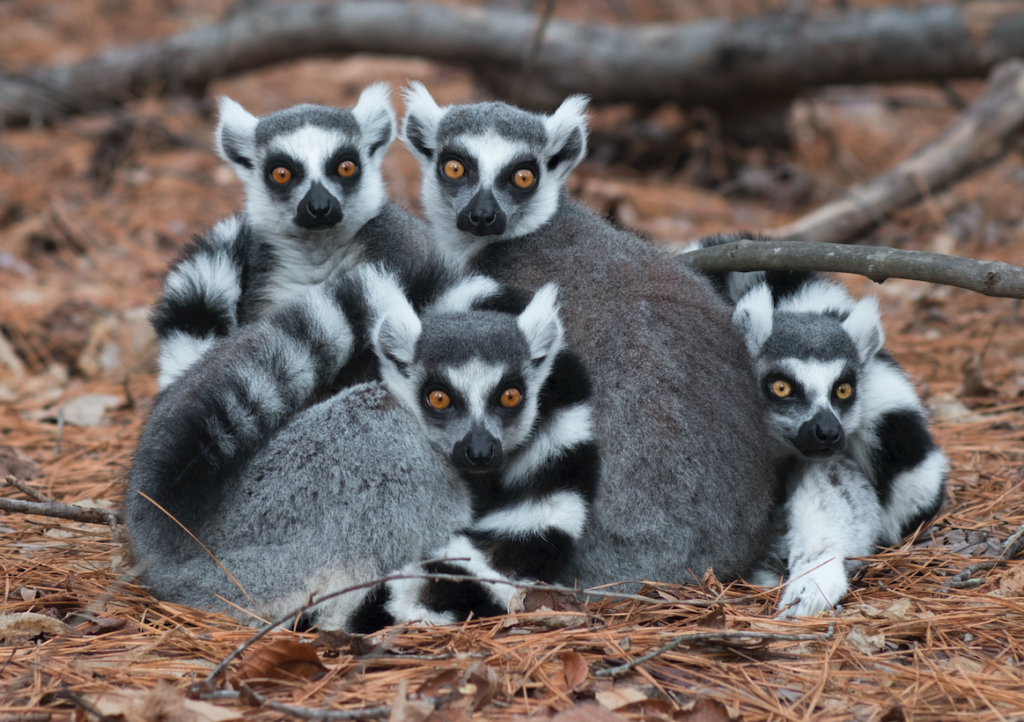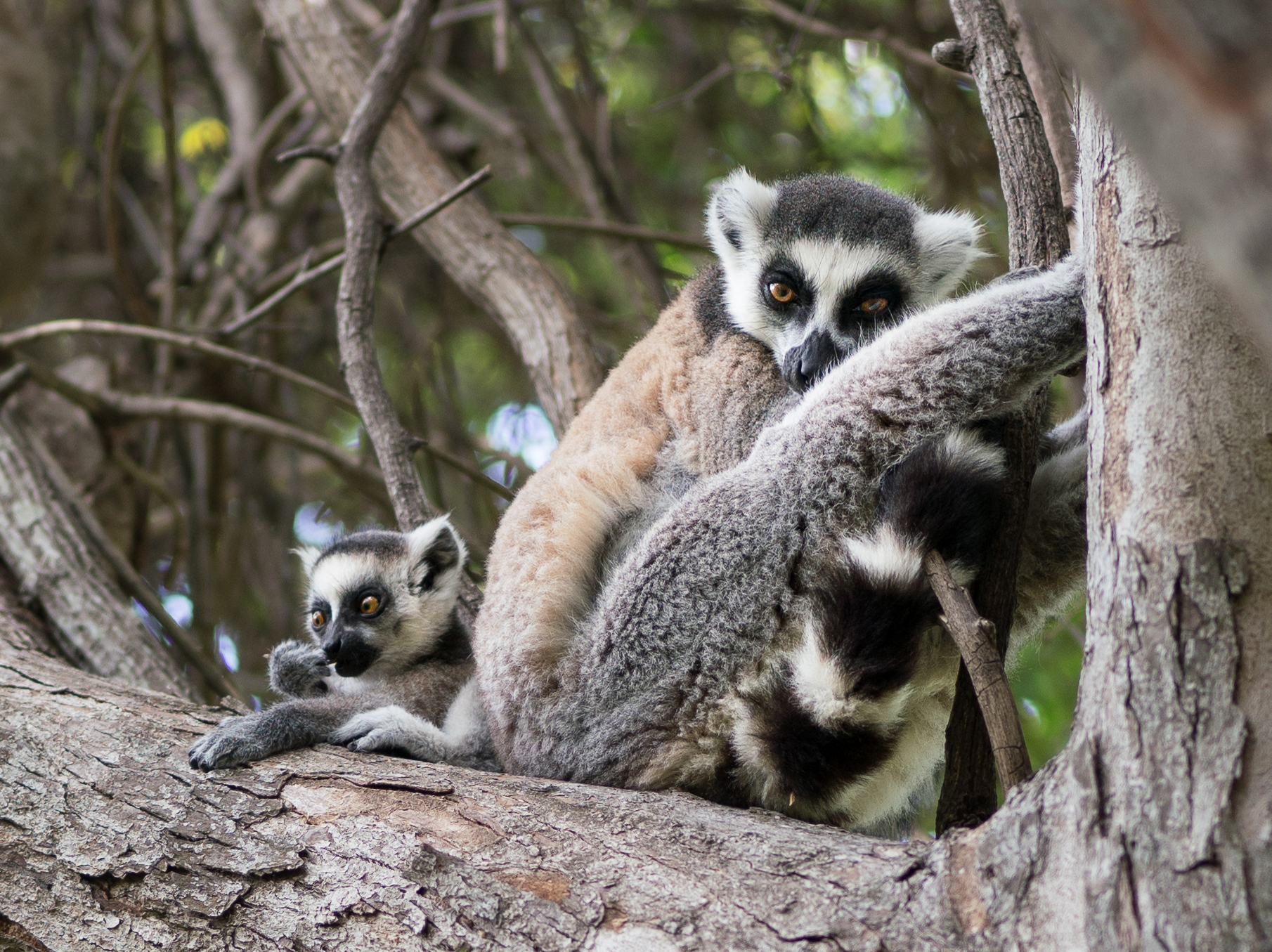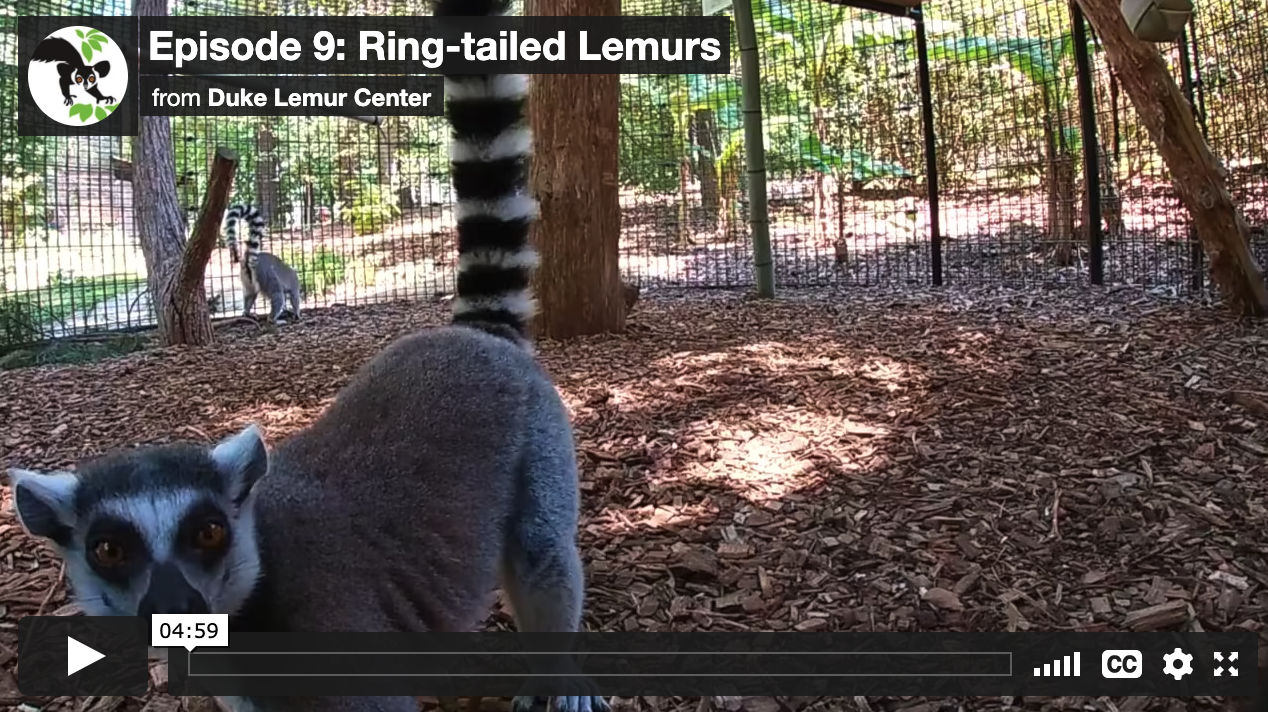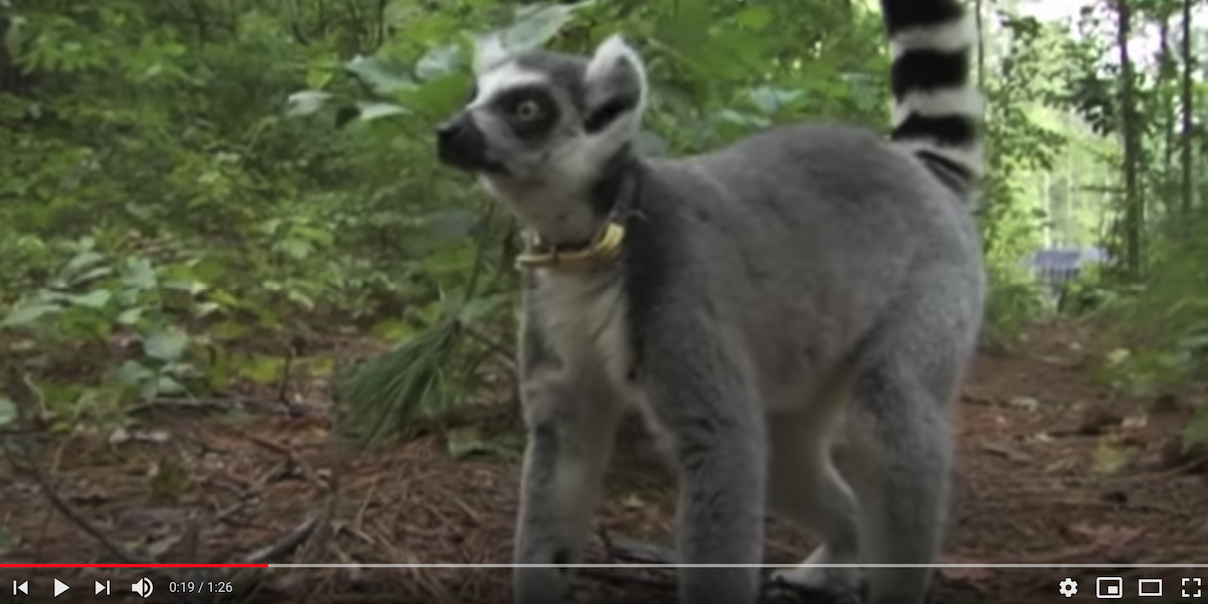Lemur catta
Ring-tailed lemurs (Lemur catta) are the most well studied of all the lemurs. They’re also the most easily recognizable species of lemur, and the most common primates in human care. Although widely distributed throughout the dry forests of southwestern Madagascar (some of the hottest, driest, and least hospitable forests in the country), they exist in only a few protected areas.
Unfortunately, the sparse, level forests inhabited by ring-tails are easily felled, even with limited tools. Hence ring-tailed lemur habitat is shrinking at an alarming rate. In fact, satellite images suggest that ring-tailed lemur habitat is vanishing at an even greater rate than forest habitat in other parts of Madagascar.
Due to the large number of L. catta in human care, the ring-tailed lemur Species Survival Plan calls for only a few breeding pairs of animals each year so that precious captive breeding space can be occupied by the rarer species of lemurs.
About Ring-tailed Lemurs
Adopt a Ring-tailed Lemur

Want to learn more about ring-tailed lemurs AND help support their care and conservation not only here but also in Madagascar? Consider symbolically adopting Randy, a male ring-tailed lemur, through the DLC’s Adopt a Lemur Program! Your adoption goes toward the $8,400 per year cost it takes to care for each lemur at the DLC, as well as aiding our conservation efforts in Madagascar. You’ll also receive quarterly updates and photos, making this a fun, educational gift that keeps giving all year long!
Why Ring-tailed Lemurs Should Not Be Kept as Pets
In the US, ring-tailed lemurs are occasionally marketed as pets and are legal to own in some states. The pet trade can have devastating consequences for both the lemur and its owner, and the Duke Lemur Center is absolutely against all trade in pet primates, and against the holding of any prosimian (lemur, loris, bushbaby, potto) as a pet.
To learn why ring-tails and other lemurs should never be kept as pets, please read "How Much Is That Lemur in the Window?," an article originally published in the DLC's 2019 annual magazine. The DLC's formal position statement on pet lemurs is also available online.
How You Can Help
Even if you never own a pet lemur yourself, there are choices you can make to reduce others’ interest in lemurs as pets.
The Association of Zoos and Aquariums (AZA) has reported that viewing lemurs in contact with humans increases the public perception that they are suitable as pets. Avoid businesses and wildlife parks that offer contact with lemurs or other wild animals, such as yoga with lemurs or hands-on “encounters” involving touching or feeding. This is one of many reasons the DLC does not allow visitors to touch or directly interact with our animals.
Videos and selfies where humans and animals are in direct contact go viral all the time. After a clip of a ring-tailed lemur motioning for a child to pet it accrued millions of views, there was a dramatic increase in Google searches for the phrase “pet lemur.” The next time you come across a video of a pet lemur in a bathtub, or a photo of a diapered ring-tail perched on someone’s shoulder, don’t share it.
Video
Ring-tailed lemurs are featured in episode nine of our FREE virtual tour series! With their stripy tails, stinky habits, and girl-power attitude, these primates are sure to inspire some lemur love. In this video, we also talk about why the best way to love lemurs is to respect them as wild animals—one of many reasons lemurs should never be kept as pets.
Many animals at the Duke Lemur Center have access to large, multi-acre areas of enclosed forest called Natural Habitat Enclosures. In this video, a trio of ring-tailed lemurs can be seen enjoying the cool weather before a rain shower.
Ring-tailed lemurs frequently give birth to twins. While this means twice the work for mom, it also means the youngsters can keep each other occupied! Watch twin sisters Hedwig and Griselda wrestle in the forest as mom, Leisl, takes some time to herself.
Diet
Ring-tailed lemurs' diet consists of fruit, leaves, flowers, bark, sap, and the occasional invertebrate. Due to the fact that vegetation in forests inhabited by these lemurs is sparse and non-continuous, they are often found traveling on the ground. As an adaptation to survival in a harsh climate, ring-tails range far and feed on a wide variety of vegetation.
Reproduction

During breeding season in Madagascar, competition between the normally “laid back” males becomes fierce as they fight for the right to breed. Like other lemurs, breeding is highly seasonal with all females going into estrus in the same season. At the Duke Lemur Center, all breeding is regulated by a Species Survival Plan which means our males do not have to challenge one another for access to females.
Ring-tailed females usually give birth first at three years of age and produce offspring annually thereafter. In the wild, mating begins in mid-April with infants born in August and September. Single infants are most common, but twins are a frequent sight in ringtail troops when food is plentiful.
Initially, infants cling to their mothers’ bellies but can be seen riding, jockey style, on their backs after approximately three weeks. Infants begin to sample solid food after their first week and will take their first steps away from mom at 3-4 weeks. Over the next five months, infants will spend increasing amounts of time on their own, returning to mom to nurse or sleep, until they are finally weaned at 5-6 months of age
Behavior

Ring-tails are the most terrestrial of all the lemurs. They spend more time on the ground (as opposed to in the trees) than any other lemur species—up to 50% of their day!
Ring-tail groups are larger than any other lemur group, containing up to 30 animals.
There is a well-defined hierarchy within each group. Females are dominant over all males with the alpha female forming the focal point for the group as a whole. Females live in one group their entire lives, while males migrate from group to group.
When ring-tailed troops travel throughout their home range, they keep their tails raised in the air like flags to keep group members together. Constant vocalizations among members also keep the group together. One of the most vocal primates, ring-tails have a large vocabulary of at least 28 different calls. These include several different types of alarm calls, which alert group members to potential danger.
Ring-tails bask in the sun in groups (sun worshipping), absorbing the warmth of the sun through their less dense belly fur.
Ring-tails can often be found combing each others’ fur. With the exception of the aye-aye, all lemurs’ bottom teeth form a special “toothcomb” structure, which they use for grooming themselves and other lemurs. Social grooming, seen in this video by DLC communications intern Laura Jones, is an instinctive social behavior that is not just hygienic but also strengthens the social bonds within the group.
Male ring-tails are equipped with scent glands on their wrists which are used in stink fighting with rival males. Two males stand facing each other a few feet apart and, repeatedly drawing their tails through these glands, proceed to wave the tails over their heads, all the while staring in a hostile fashion at their rival. Eventually, one of the males will break down and run away. Want to see it for yourself? Watch this video of ring-tail lemurs stink fighting in Madagascar, filmed by researcher Marni LeFleur.
In jump fights, males compete for females by leaping into the air slashing with their sharp canine teeth. These sharp teeth are one of many reasons ring-tailed lemurs should not be kept as pets!
Scent Marking

Six-year-old male ring-tailed lemur Jones (pictured above) may look like he is a lemur somewhat lacking in arms as he sniffs a sapling in Natural Habitat Enclosure #9, but rest assured, he is a well-armed male in the prime of life! His odd posture is due to the fact that, in typical male ring-tail marking behavior, he is mixing secretions produced by scent glands on the insides of his wrists (antebrachial glands) with stinky secretions produced by glands on his chest (brachial glands). When the two secretions are well mixed, Jones can proceed to mark his territory with his wrist glands (which he will wind up doing here) or, if he were facing a rival, thoroughly anoint his tail for a stink fight.
A ring-tailed lemur’s distinctive scent can communicate volumes about his genetics — which probably useful in avoiding aggression with closely related males, likely helps prevent inbreeding by signaling family relationships to females — and his fitness for breeding. Each lemur’s musky scent contains at least “203 different chemical compounds in a complex mix that has been found to vary not only by season, but by an individual’s genetics as well.” The scent can even change when a lemur is ill or socially stressed. (See Primate’s Scent Speaks Volumes about the research of Christine Drea, a Duke researcher who studies scent in ring-tailed lemurs.)
Male ring-tails have scent glands on their wrists, chest, and scrotum — and each produces a different scent. Females have just one scent gland, which is located in the genital area. Drea has discovered that female ring-tails’ scent is more complex than the males’. Via scent, females may advertise not only their fertility, but the presence of a pregnancy and how far along it is. (See Primate’s Scent Speaks Volumes.)
When this photo of Jones was taken, peak breeding season (October-November in North Carolina) for ring-tailed lemurs was fast approaching. In preparation for facing rivals, males begin to significantly beef up in late summer (in more ways than by just putting on weight… !) and a close look at Jones will reveal that his time at the jungle gym has indeed been well spent, as he is in peak breeding season form! Alas for Jones, there were no ring-tailed lemur females designated for breeding at the DLC that fall, so he had to be content with just stinking up the place!
Habitat and Conservation

Ring-tailed lemurs are found in south and southwestern Madagascar, from Fort-Dauphin west and as far north as Morandava on the west coast. A small additional population lives near the mountains of Andringitra on the southeastern plateau. [Above and below: wild ring-tailed lemur mothers and infants photographed in Anja Community Reserve in Ambalavao, Madagascar.]
The gallery forests that ring-tailed lemurs prefer are rapidly being converted to farmland, overgrazed by livestock, and harvested for charcoal production. Ring-tailed lemurs are also hunted for food in certain areas of their range and are frequently kept as pets. Fortunately, ring-tails are found in several protected areas in southern Madagascar, but the level of protection varies widely in these areas, offering only some populations refuge from hunting and habitat loss.
Ring-tailed lemurs breed well in human care, and over 1,000 can be found at approximately 140 zoos around the world.

Quick Facts
Adult size: 4.9 - 6 lbs (2.2 - 2.7 kg)
Social structure: large groups of up to 30 with one dominant female in Madagascar, family groups with a dominant female at the DLC
Habitat: deciduous thicket and spiny desert in southern Madagascar
Diet: Fruit, leaves, flowers, herbs, other plant parts. Occasionally they will also eat insects and small vertebrates (especially in the dry season when food is scarce).
Sexual maturity: 3 years
Mating: highly seasonal, April - May in Madagascar, October - November in Durham.
Gestation: 135 days
Number of young: 1 - 3 per season. One is most common but twins are not rare if food is plentiful.
IUCN Status: endangered
DLC Naming theme: Greek, sodas, Austrian, famous literary characters
Malagasy name: maky
How You Can Help
Send a lemur a present: You can send special treats to the DLC’s lemurs, as well as raw materials for us to construct special enrichment activities to keep them happy and healthy. Simply visit our amazon.com wishlist!
Symbolically adopt a ring-tailed lemur: Want to learn more about this species AND help support their care, not only here but also in Madagascar? Consider symbolically adopting Randy, a ring-tailed lemur, through the DLC’s Adopt a Lemur program! Adoption packages start at just $50.
Visit the Duke Lemur Center: The DLC is only partially funded by Duke, so we rely heavily on revenue from tours to help pay for lemur care and housing as well as our conservation work in Madagascar. So, something as simple and fun as visiting the Lemur Center can help us help the lemurs!
Don't promote ring-tails as pets: In the United States, ring-tailed lemurs are occasionally marketed as pets, and the pet trade can have devastating consequences for both the lemur and its owner. Even if you never own a pet lemur yourself, there are choices you can make to reduce others’ interest in lemurs as pets. See the "Why Ring-tails Should Not Be Kept As Pets" tab above to learn more.
Engage in conservation locally: Though it doesn't directly affect lemurs, the DLC also promotes local conservation. We encourage visitors to support local ecosystems and protect local habitats, similar to the way we're helping the local people in Madagascar preserve lemurs' natural habitat. A fun way to do this is to plant a local pollinators garden at your home or school. The DLC itself incorporated a Monarch Waystation into its landscaping for the summer tour path in 2017. You can also stop using dangerous chemicals on your lawn, which might end up in lakes and streams and harm fish, frogs, and other animals.

Want to learn more about ring-tailed lemurs AND help support their care and conservation not only here but also in Madagascar? Consider symbolically adopting Randy, a male ring-tailed lemur, through the DLC’s Adopt a Lemur Program! Your adoption goes toward the $8,400 per year cost it takes to care for each lemur at the DLC, as well as aiding our conservation efforts in Madagascar. You’ll also receive quarterly updates and photos, making this a fun, educational gift that keeps giving all year long!
In the US, ring-tailed lemurs are occasionally marketed as pets and are legal to own in some states. The pet trade can have devastating consequences for both the lemur and its owner, and the Duke Lemur Center is absolutely against all trade in pet primates, and against the holding of any prosimian (lemur, loris, bushbaby, potto) as a pet.
To learn why ring-tails and other lemurs should never be kept as pets, please read "How Much Is That Lemur in the Window?," an article originally published in the DLC's 2019 annual magazine. The DLC's formal position statement on pet lemurs is also available online.
How You Can Help
Even if you never own a pet lemur yourself, there are choices you can make to reduce others’ interest in lemurs as pets.
The Association of Zoos and Aquariums (AZA) has reported that viewing lemurs in contact with humans increases the public perception that they are suitable as pets. Avoid businesses and wildlife parks that offer contact with lemurs or other wild animals, such as yoga with lemurs or hands-on “encounters” involving touching or feeding. This is one of many reasons the DLC does not allow visitors to touch or directly interact with our animals.
Videos and selfies where humans and animals are in direct contact go viral all the time. After a clip of a ring-tailed lemur motioning for a child to pet it accrued millions of views, there was a dramatic increase in Google searches for the phrase “pet lemur.” The next time you come across a video of a pet lemur in a bathtub, or a photo of a diapered ring-tail perched on someone’s shoulder, don’t share it.
Ring-tailed lemurs are featured in episode nine of our FREE virtual tour series! With their stripy tails, stinky habits, and girl-power attitude, these primates are sure to inspire some lemur love. In this video, we also talk about why the best way to love lemurs is to respect them as wild animals—one of many reasons lemurs should never be kept as pets.
Many animals at the Duke Lemur Center have access to large, multi-acre areas of enclosed forest called Natural Habitat Enclosures. In this video, a trio of ring-tailed lemurs can be seen enjoying the cool weather before a rain shower.
Ring-tailed lemurs frequently give birth to twins. While this means twice the work for mom, it also means the youngsters can keep each other occupied! Watch twin sisters Hedwig and Griselda wrestle in the forest as mom, Leisl, takes some time to herself.
Ring-tailed lemurs' diet consists of fruit, leaves, flowers, bark, sap, and the occasional invertebrate. Due to the fact that vegetation in forests inhabited by these lemurs is sparse and non-continuous, they are often found traveling on the ground. As an adaptation to survival in a harsh climate, ring-tails range far and feed on a wide variety of vegetation.

During breeding season in Madagascar, competition between the normally “laid back” males becomes fierce as they fight for the right to breed. Like other lemurs, breeding is highly seasonal with all females going into estrus in the same season. At the Duke Lemur Center, all breeding is regulated by a Species Survival Plan which means our males do not have to challenge one another for access to females.
Ring-tailed females usually give birth first at three years of age and produce offspring annually thereafter. In the wild, mating begins in mid-April with infants born in August and September. Single infants are most common, but twins are a frequent sight in ringtail troops when food is plentiful.
Initially, infants cling to their mothers’ bellies but can be seen riding, jockey style, on their backs after approximately three weeks. Infants begin to sample solid food after their first week and will take their first steps away from mom at 3-4 weeks. Over the next five months, infants will spend increasing amounts of time on their own, returning to mom to nurse or sleep, until they are finally weaned at 5-6 months of age

Ring-tails are the most terrestrial of all the lemurs. They spend more time on the ground (as opposed to in the trees) than any other lemur species—up to 50% of their day!
Ring-tail groups are larger than any other lemur group, containing up to 30 animals.
There is a well-defined hierarchy within each group. Females are dominant over all males with the alpha female forming the focal point for the group as a whole. Females live in one group their entire lives, while males migrate from group to group.
When ring-tailed troops travel throughout their home range, they keep their tails raised in the air like flags to keep group members together. Constant vocalizations among members also keep the group together. One of the most vocal primates, ring-tails have a large vocabulary of at least 28 different calls. These include several different types of alarm calls, which alert group members to potential danger.
Ring-tails bask in the sun in groups (sun worshipping), absorbing the warmth of the sun through their less dense belly fur.
Ring-tails can often be found combing each others’ fur. With the exception of the aye-aye, all lemurs’ bottom teeth form a special “toothcomb” structure, which they use for grooming themselves and other lemurs. Social grooming, seen in this video by DLC communications intern Laura Jones, is an instinctive social behavior that is not just hygienic but also strengthens the social bonds within the group.
Male ring-tails are equipped with scent glands on their wrists which are used in stink fighting with rival males. Two males stand facing each other a few feet apart and, repeatedly drawing their tails through these glands, proceed to wave the tails over their heads, all the while staring in a hostile fashion at their rival. Eventually, one of the males will break down and run away. Want to see it for yourself? Watch this video of ring-tail lemurs stink fighting in Madagascar, filmed by researcher Marni LeFleur.
In jump fights, males compete for females by leaping into the air slashing with their sharp canine teeth. These sharp teeth are one of many reasons ring-tailed lemurs should not be kept as pets!

Six-year-old male ring-tailed lemur Jones (pictured above) may look like he is a lemur somewhat lacking in arms as he sniffs a sapling in Natural Habitat Enclosure #9, but rest assured, he is a well-armed male in the prime of life! His odd posture is due to the fact that, in typical male ring-tail marking behavior, he is mixing secretions produced by scent glands on the insides of his wrists (antebrachial glands) with stinky secretions produced by glands on his chest (brachial glands). When the two secretions are well mixed, Jones can proceed to mark his territory with his wrist glands (which he will wind up doing here) or, if he were facing a rival, thoroughly anoint his tail for a stink fight.
A ring-tailed lemur’s distinctive scent can communicate volumes about his genetics — which probably useful in avoiding aggression with closely related males, likely helps prevent inbreeding by signaling family relationships to females — and his fitness for breeding. Each lemur’s musky scent contains at least “203 different chemical compounds in a complex mix that has been found to vary not only by season, but by an individual’s genetics as well.” The scent can even change when a lemur is ill or socially stressed. (See Primate’s Scent Speaks Volumes about the research of Christine Drea, a Duke researcher who studies scent in ring-tailed lemurs.)
Male ring-tails have scent glands on their wrists, chest, and scrotum — and each produces a different scent. Females have just one scent gland, which is located in the genital area. Drea has discovered that female ring-tails’ scent is more complex than the males’. Via scent, females may advertise not only their fertility, but the presence of a pregnancy and how far along it is. (See Primate’s Scent Speaks Volumes.)
When this photo of Jones was taken, peak breeding season (October-November in North Carolina) for ring-tailed lemurs was fast approaching. In preparation for facing rivals, males begin to significantly beef up in late summer (in more ways than by just putting on weight… !) and a close look at Jones will reveal that his time at the jungle gym has indeed been well spent, as he is in peak breeding season form! Alas for Jones, there were no ring-tailed lemur females designated for breeding at the DLC that fall, so he had to be content with just stinking up the place!

Ring-tailed lemurs are found in south and southwestern Madagascar, from Fort-Dauphin west and as far north as Morandava on the west coast. A small additional population lives near the mountains of Andringitra on the southeastern plateau. [Above and below: wild ring-tailed lemur mothers and infants photographed in Anja Community Reserve in Ambalavao, Madagascar.]
The gallery forests that ring-tailed lemurs prefer are rapidly being converted to farmland, overgrazed by livestock, and harvested for charcoal production. Ring-tailed lemurs are also hunted for food in certain areas of their range and are frequently kept as pets. Fortunately, ring-tails are found in several protected areas in southern Madagascar, but the level of protection varies widely in these areas, offering only some populations refuge from hunting and habitat loss.
Ring-tailed lemurs breed well in human care, and over 1,000 can be found at approximately 140 zoos around the world.

Adult size: 4.9 - 6 lbs (2.2 - 2.7 kg)
Social structure: large groups of up to 30 with one dominant female in Madagascar, family groups with a dominant female at the DLC
Habitat: deciduous thicket and spiny desert in southern Madagascar
Diet: Fruit, leaves, flowers, herbs, other plant parts. Occasionally they will also eat insects and small vertebrates (especially in the dry season when food is scarce).
Sexual maturity: 3 years
Mating: highly seasonal, April - May in Madagascar, October - November in Durham.
Gestation: 135 days
Number of young: 1 - 3 per season. One is most common but twins are not rare if food is plentiful.
IUCN Status: endangered
DLC Naming theme: Greek, sodas, Austrian, famous literary characters
Malagasy name: maky
Send a lemur a present: You can send special treats to the DLC’s lemurs, as well as raw materials for us to construct special enrichment activities to keep them happy and healthy. Simply visit our amazon.com wishlist!
Symbolically adopt a ring-tailed lemur: Want to learn more about this species AND help support their care, not only here but also in Madagascar? Consider symbolically adopting Randy, a ring-tailed lemur, through the DLC’s Adopt a Lemur program! Adoption packages start at just $50.
Visit the Duke Lemur Center: The DLC is only partially funded by Duke, so we rely heavily on revenue from tours to help pay for lemur care and housing as well as our conservation work in Madagascar. So, something as simple and fun as visiting the Lemur Center can help us help the lemurs!
Don't promote ring-tails as pets: In the United States, ring-tailed lemurs are occasionally marketed as pets, and the pet trade can have devastating consequences for both the lemur and its owner. Even if you never own a pet lemur yourself, there are choices you can make to reduce others’ interest in lemurs as pets. See the "Why Ring-tails Should Not Be Kept As Pets" tab above to learn more.
Engage in conservation locally: Though it doesn't directly affect lemurs, the DLC also promotes local conservation. We encourage visitors to support local ecosystems and protect local habitats, similar to the way we're helping the local people in Madagascar preserve lemurs' natural habitat. A fun way to do this is to plant a local pollinators garden at your home or school. The DLC itself incorporated a Monarch Waystation into its landscaping for the summer tour path in 2017. You can also stop using dangerous chemicals on your lawn, which might end up in lakes and streams and harm fish, frogs, and other animals.





